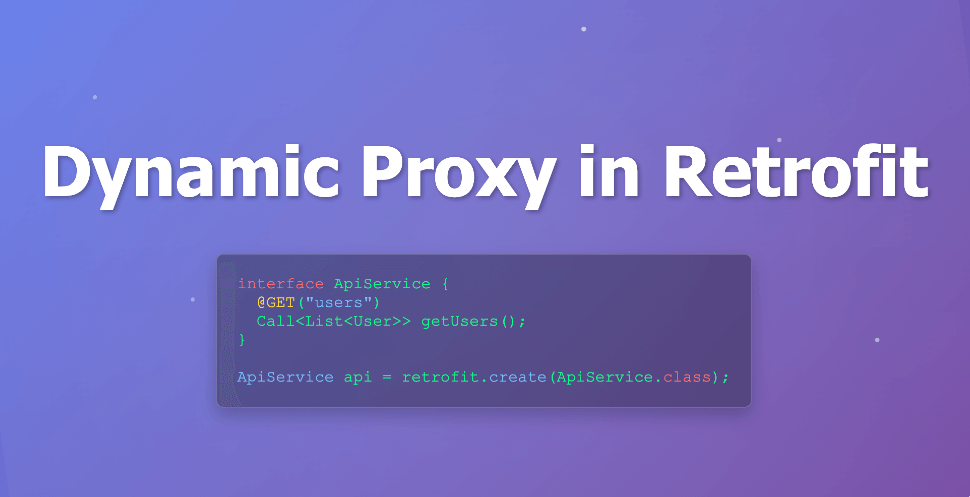
Retrofit is a type-safe HTTP client for Android and Java. You just define interfaces, and it generates the implementation for you at runtime — but how?
The secret is Java’s Dynamic Proxy mechanism.
interface ApiService {
@GET("users")
Call<List<User>> getUsers();
}
// Retrofit magically creates an implementation
ApiService api = retrofit.create(ApiService.class);
api.getUsers();Dynamic proxies in Java allow you to create objects that implement one or more interfaces during runtime.
Imagine this: You have a Calculator class with add() and subtract() methods.
public interface Calculator {
int add(int a, int b);
int subtract(int a, int b);
}And the implementation:
public class CalculatorImpl implements Calculator {
public int add(int a, int b) {
return a + b;
}
public int subtract(int a, int b) {
return a - b;
}
}Now imagine your team needs to add logging to track method calls for debugging. You have several options, but let’s see why dynamic proxy is the best choice.
- You could modify CalculatorImpl class directly by adding print statements in each method but it violates Open/Closed Principle, breaks the Single Responsibility Principle, and creates scalability issues or
- Implement manual/static proxy by manually creating a class that implements the same interface as the real object, holds a reference to it, and adds extra behavior (like logging) before or after forwarding method calls, like below example.
public class CalculatorLogger implements Calculator {
private final Calculator target;
public CalculatorLogger(Calculator target) {
this.target = target;
}
@Override
public int add(int a, int b) {
System.out.println("Calling method: add");
return target.add(a, b);
}
@Override
public int subtract(int a, int b) {
System.out.println("Calling method: subtract");
return target.subtract(a, b);
}
}But Manual/Static Proxy has following disadvantages:
- Code Duplication: You write similar proxy code for each interface.
- Not Scalable: For many interfaces, maintenance becomes tedious.
- Tightly Coupled: Changes in the interface may require proxy updates.
- Boilerplate Code: Adds repetitive and verbose code manually.
Dynamic Proxy
Wouldn’t it be better to intercept method calls from the outside, add logging, and leave the original logic untouched?
That’s what a dynamic proxy lets you do. A dynamic proxy is an object created at runtime that implements one or more interfaces and forwards all method calls to a special handler, allowing you to add custom behavior.
To create a dynamic proxy, you use the Proxy.newProxyInstance() method.
Object Proxy.newProxyInstance(
ClassLoader loader,
Class<?>[] interfaces,
InvocationHandler handler
)What Do These Parameters Mean?
| Parameter | Type | Description |
|---|---|---|
loader | ClassLoader | The class loader that will define the proxy class. Usually, use the same class loader as your interface: YourInterface.class.getClassLoader(). |
interfaces | Class<?>[] | An array of interfaces the proxy should implement. The proxy will behave as if it’s an instance of these interfaces. |
handler | InvocationHandler | A custom handler that intercepts method calls. Every method call on the proxy is routed through the invoke() method of this handler. |
Step 1: The InvocationHandler
import java.lang.reflect.InvocationHandler;
import java.lang.reflect.Method;
public class CalculatorInvocationHandler implements InvocationHandler {
private final Object target;
public CalculatorInvocationHandler(Object target) {
this.target = target;
}
@Override
public Object invoke(Object proxy, Method method, Object[] args) throws Throwable {
System.out.println("Calling method: " + method.getName());
return method.invoke(target, args);
}
}Step 2: Create the Proxy and Use It
import java.lang.reflect.Proxy;
public class DynamicProxyExample {
public static void main(String[] args) {
Calculator realCalculator = new CalculatorImpl();
Calculator proxy = (Calculator) Proxy.newProxyInstance(
Calculator.class.getClassLoader(), // ClassLoader
new Class[]{Calculator.class}, // Interfaces to implement
new CalculatorInvocationHandler(realCalculator) // Custom InvocationHandler
);
System.out.println("Add: " + proxy.add(5, 2));
System.out.println("Subtract: " + proxy.subtract(8, 3));
}
}Output:
Calling method: add
Add: 7
Calling method: subtract
Subtract: 5Mini Retrofit Example
Now that we’ve seen how Java’s dynamic proxies work, here’s a simplified example inspired by Retrofit.
This simulation shows how a MiniRetrofit class can dynamically generate implementations for multiple service interfaces — without writing manual code for each one.
Notice how both UserService and ProductService are handled using the same reusable proxy logic. This is how Retrofit avoids boilerplate and scales cleanly across many APIs.
import java.lang.reflect.InvocationHandler;
import java.lang.reflect.Method;
import java.lang.reflect.Proxy;
// 1. Define API interfaces
interface UserService {
Object getUsers();
Object createUser();
}
interface ProductService {
Object getProducts();
Object addProduct();
}
// 2. MiniRetrofit-like class that creates dynamic proxies
class MiniRetrofit {
public static <T> T create(Class<T> serviceInterface) {
return (T) Proxy.newProxyInstance(
serviceInterface.getClassLoader(),
new Class[]{serviceInterface},
new InvocationHandler() {
@Override
public Object invoke(Object proxy, Method method, Object[] args) {
// 1. Receive which interface method was called via the 'method' parameter
// 2. Look up metadata for that method (such as HTTP method, URL path, etc.)
// 3. Dynamically build and execute the HTTP request based on the metadata and arguments
// 4. Return the appropriate result (e.g., a Call object, a coroutine Deferred, a CompletableFuture, or other supported types)
return null; // Simulated return
}
}
);
}
}
// 3. Usage
public class Demo {
public static void main(String[] args) {
UserService userService = MiniRetrofit.create(UserService.class);
ProductService productService = MiniRetrofit.create(ProductService.class);
userService.getUsers();
userService.createUser();
productService.getProducts();
productService.addProduct();
System.out.println("Simulated Retrofit-like behavior with multiple services using dynamic proxy.");
}
}With this setup, the proxy intercepts method calls and injects logic dynamically.
Note: Dynamic proxies shouldn’t be used for concrete classes (only works with interfaces), performance-critical code (reflection overhead). Reflection overhead in Retrofit is tiny compared to waiting for HTTP responses.
Retrofit’s elegance lies in making HTTP APIs feel like local method calls. For instance, when you call api.getCountries(), you’re triggering a runtime translation that converts your method signature into a complete HTTP request. The interface becomes your contract, annotations become configuration, and dynamic proxy invisibly translates. This declarative approach is why Retrofit remains the gold standard.